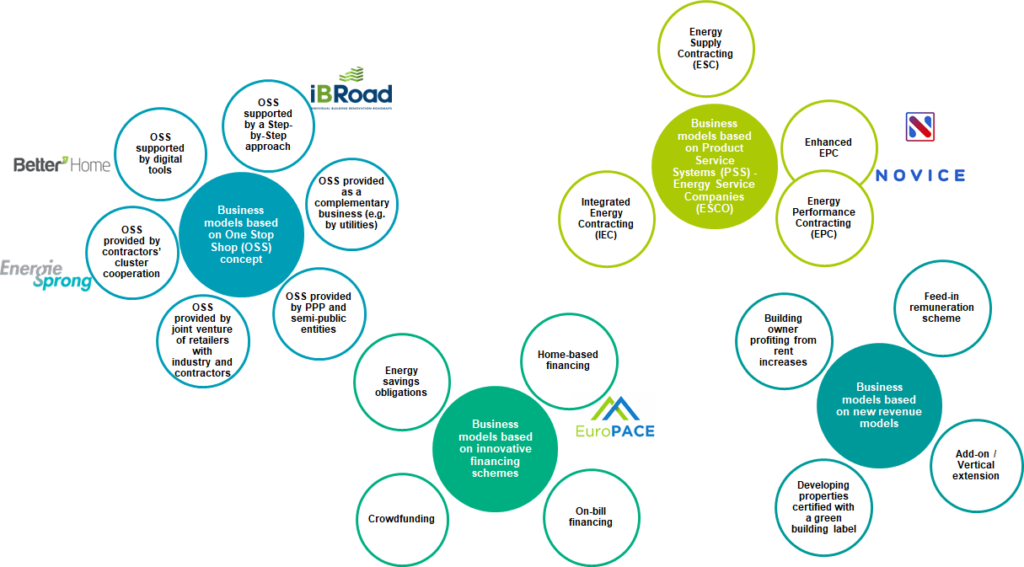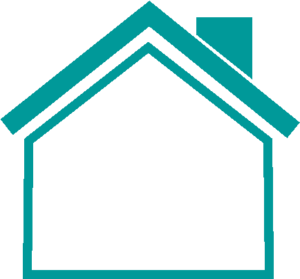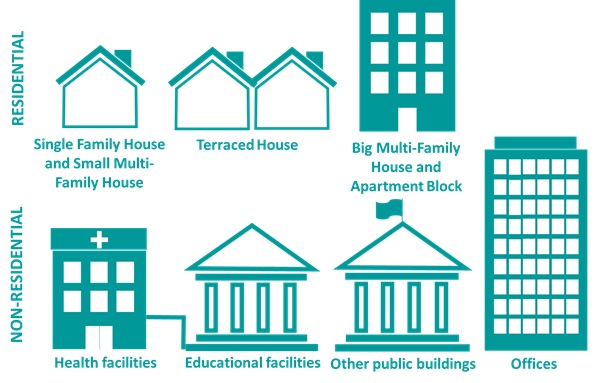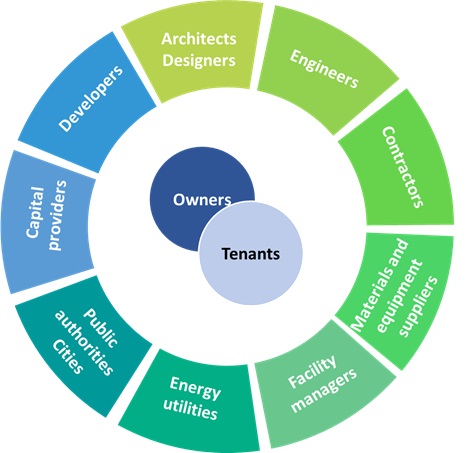What business models would suit you best?
Description
The objective of this section of the Renovation Hub is to present the variety of Business Models that already exist to support energy renovation, guide you in this large collection to find the best “recipe”, provide recommendations for replication, and illustrate the application of most promising ones through Cases Studies.
We have identified four main families of business models:

Real business models are often a combination of several business model patterns, and business model families should not be considered in isolation: on the contrary, combining several patterns can provide a more robust business model.
When setting up a renovation project, the chosen business model(s) should be tailored to the targeted market segment:
| For who? | The problem |
What? (Recommended Business Model) |
How? |
Can be combined with: | Where? (Example of countries with high potential for this BM) | |
| Type of dwelling | Type of owner | |||||
 |
Owner occupant | Renovation journey too costly and complex for the home owner | One Stop Shop | Provided by PPP / semi-public entities | Countries with incentives for home owners to renovate | |
| Supported by a digital tool | Denmark, Germany | |||||
 |
Social housing | Renovation in occupied dwellings. Acceptance by tenants | One-Stop-Shop “Energiesprong” | Initiated by a dedicated marketing team | Add-on business model | Netherland, Denmark, Germany, UK |
| Energy Performance Contracting | Provided by an ESCO | Collective Self Consumption | France, Denmark | |||
 |
Condominiums | Renovation in occupied dwellings. Acceptance by multiple owners. | One Stop Shop | Provided by semi-public entities | Step by Step approach | Germany, France, Denmark |
 |
Public buildings | Upfront investment. Long term estate management | Energy Performance Contracting | Provided by an ESCO | Crowdfunding (for cultural heritage) | France, Denmark |
 |
Offices and other tertiary buildings | Attractivity of estates for companies / lessees | Energy Performance Contracting | Provided by an ESCO | France, Denmark | |
Other types of Business Models you may be interested in:
Other One-Stop-Shops
- OSS provided as a complementary business (e.g. by utilities, insurances)
- OSS provided by joint venture of retailers with industry and contractors
- OSS provided by SME contractors’ cluster cooperation
- OSS with home-based financing
Energy as a service:
New and innovative revenue models
New financing schemes
Each Business Model presentation is structured in four blocks: What? Who? How? Why?
"What” (value proposition)
The „What“ section describes what is offered to the target customer and is commonly referred to as the value proposition. It can be defined as a holistic view of a company’s bundle of products and services that are of value to the customer and represents the added value that a certain Business Model provides to the target customers.
WHAT – Recommendations when setting up a new renovation service:
- Address key selling points for the end-customer: accessibility, comfort, status/ reputation – energy efficiency comes on top. Put forward the global comfort and go beyond the energy performance
- Create trust and simplify the customer journey (e.g. with One Stop Shops, renovation coordinators / coaches, main contractor, etc.)
- Build confidence from clients thanks to performance guarantee
"Who” (target customer)

Every business model serves a certain customer group, thus the definition of the target customer is one central dimension in designing a new business model. In the context of the Renovation Hub, the customers are the owners of the buildings to be renovated, and their nature (e.g. public, single owner, multi-owners, social housing association, etc.) is often correlated to the type of building that it is considered for renovation. When possible, the way of reaching and attracting the target customers is also presented in this section (customer channels).
WHO – Recommendations when setting up a new renovation service:
- When setting up a renovation service, identify subsegments and what triggers renovation for each of them (i.e. purchase of a new house) and develop a new (local) business model around that (with synchronisation of incentives)
- Communication is key: tailor the messages to the targets. Support local peer-to-peer learning
- Use influencers to speed up the changes
"How” (value chain, activities, resources)
The third section describes how to build and distribute the value proposition, in terms of processes and activities, along with the involved resources and capabilities. The key partners for delivering the added value to the target customers as well as the technologies and processes involved in terms of refurbishment solutions are detailed in this section. The involvement of the different stakeholders within the renovation value chain, depending on each specific business model, is illustrated by highlighting the key actors on the “Stakeholder map”.
HOW – Recommendations when setting up a new renovation service:
- Focus on the integration of all actors and integrate the local market
- Build national synergies and alliances, engage with local stakeholders
- Dedicate resources to the training & upskilling of contractors & installers (including digitalisation), with a systemic approach to ensure that the overall performance (energy, comfort, etc.) is well accounted for and that the different trades collaborate more efficiently

"Why” (revenue model and cost structure)
The fourth section explains why the business model is financially viable. In essence, it unifies aspects such as the cost structure and the applied revenue mechanisms, generally from the point of view of the market actor using this business model to sell a service or a product.
WHY – Recommendations when setting up a new renovation service:
- Convince bank and financial institutions to think in NPV, well-being instead of payback
- Compare the investment cost with the cost of doing nothing (Business as Usual) – implement risk management in business models
- If not already done and if possible, set up incentives to encourage deep renovation – including staged incentives to better support Step-by-Step approaches
- More specifically with regard to procurement processes:
- Encourage long-term partnerships (not on a project basis)
- Support innovation to accelerate its uptake (in particular for central governments) – see EU guidelines on Public Procurement of Innovation
Some of the business models are illustrated by concrete examples of their implementation by market players (in those cases, the corresponding example is downloadable as a pdf).





